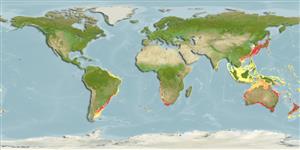Environment: milieu / climate zone / depth range / distribution range
Ecology
Marine; demersal; depth range 10 - 360 m (Ref. 33352). Subtropical
Western Pacific: southern Japan (Ref. 559) to Australia (New South Wales, South Australia, and Tasmania) and New Zealand (Ref. 5755). Southeast Atlantic: south coast of South Africa (Ref. 11228). Also found in Southwestern Atlantic: Argentine (Ref. 49964).
Size / Weight / Age
Maturity: Lm ? range ? - ? cm
Max length : 35.0 cm SL male/unsexed; (Ref. 559)
Found over the continental shelf and slope (Ref. 9563).
Life cycle and mating behavior
Maturity | Reproduction | Spawning | Eggs | Fecundity | Larvae
May, J.L. and J.G.H. Maxwell, 1986. Trawl fish from temperate waters of Australia. CSIRO Division of Fisheries Research, Tasmania. 492 p. (Ref. 9563)
IUCN Red List Status (Ref. 130435: Version 2024-1)
Threat to humans
Poisonous to eat
Human uses
Tools
Special reports
Download XML
Internet sources
Estimates based on models
Preferred temperature (Ref.
123201): 7.1 - 22.4, mean 16 °C (based on 535 cells).
Phylogenetic diversity index (Ref.
82804): PD
50 = 0.5000 [Uniqueness, from 0.5 = low to 2.0 = high].
Bayesian length-weight: a=0.03715 (0.01590 - 0.08679), b=2.87 (2.70 - 3.04), in cm total length, based on LWR estimates for this Genus-body shape (Ref.
93245).
Trophic level (Ref.
69278): 3.4 ±0.5 se; based on size and trophs of closest relatives
Resilience (Ref.
120179): Medium, minimum population doubling time 1.4 - 4.4 years (Preliminary K or Fecundity.).
Fishing Vulnerability (Ref.
59153): Low to moderate vulnerability (33 of 100).
